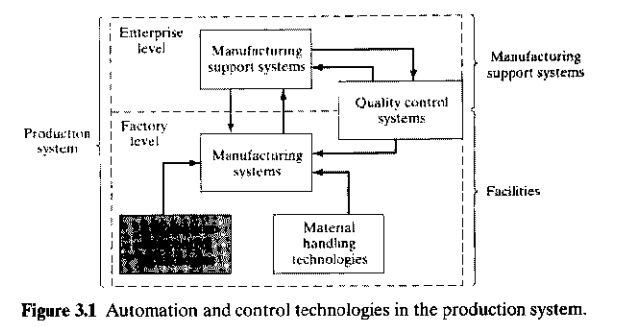Chapter: Automation, Production Systems, and Computer Integrated Manufacturing : Automotion and Control Technologies
Automotion and Control Technologies
Automotion
and Control Technologies
CONTENTS
Basic Elements
of an Automated System
Power to
Accomplish the Automated Process
Program
of Instructions
Control
System
Advanced
Automation Functions
Safety Monitoring
Maintenance
Rapair Diagnostics
Error
Detection and Recovery
Levels of
Automation
Automation is the
technology by which a
process or procedure is accomplished without
human assistance. It is implemented using a program of instructions combined with a controt system that executes the instructions, To automate a
process.power is required, both to drive
the process itself and to operate the program and control system. Although
automation can be applied in a wide variety of areas, it is most closely associated
with the manufacturing industries. It was in the context of manufacturing that
the term was originally coined hy an engineering manager at Ford Motor Company
in 1946 to describe the varicty of automatic transfer devices and feed
mechanisms that had been installed in Ford's production plants (Historical Note
3.1), It is ironic that nearly all modern applications of automation are
controlled by computer technologies that were not available in 1946.
In this
pat of the book, we examine technologies that have been developed to uutamale manufacturing operations. The
position of automation and control technologies in the larger production system
is shown in Figure 3.1. In the present chapter, we provide an

Figure 3.1 Automation and control technologies in the production system.
overview
of automation: What are the elements of an automated system? What are some of
the advanced features beyond the basic elements? And what are the levels in an
enterprise where automation can be applied? In the following two chapters, we
discuss industrial control systems and the hardware components of these
systems. These two chapters serve as a foundation for the remaining chapters in
our coverage of automation and control technologies. These technologies are:
(1) numerical control (Chapter 6), (2) industrial robotics (Chapter 7), and (3)
programmable logic controllers (Chapter 8).
Historical Note 3.1 History of
automation 1
The history of automation can be traced to the
development of basic mechanical devlcea such as the wheel (circa 3200 B.C.),
lever, winch (circa 600 B.C.), cam (circa A.D. 1000), screw (A.D. 1405). and
gear in ancient and medieval times. These basic devices were refined and used
to construct the mechanisms in waterwheels, windmills (circa A.D. 650), and
steam engines (A.D. 1765).These machines generated the power to operate other
machinery of various kinds, such as flour mills (circa 85 B.c.), weaving
machines (flying shuttle, 1733),machine tools (boring mill, 1775),steamboats (1787),and
railroad locomotives (1803). Power,
and the capacity to generate it and transmit it to operate a process, is one of
the three basic elements of an automated system.
After his first steam engine in 1765,James Watt and
his partner, Matthew Boulton,made several improvements in the design. One of
the improvements was the flyingbali governor (around 1785),which provided
feedback to control the throttle of the engine. The govemorconsisted of a ball
on the end of a hinged lever attached to the rotating shaft. The lever was
connectedtothethrottievalve.Astbespeedoftherotatingshaftincreased,the ball was
forced to move outward by centrifugal force; this in tum caused the lever to
reduce the valve opening and slow the motor speed. As rotational speed decreased,
the ball and lever relaxed, thus allowing the valve to open. The flyingball
governor was one of the first examples in englneering of feedback control, an
important type of contro/systemthe
second basic element of an automated system.
Related Topics